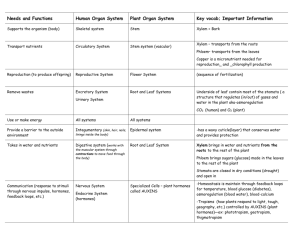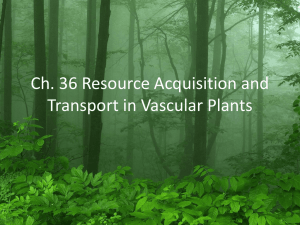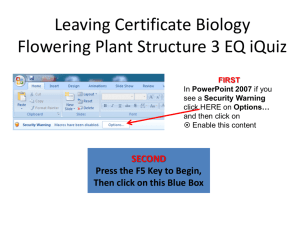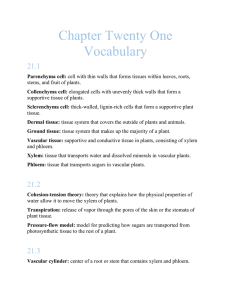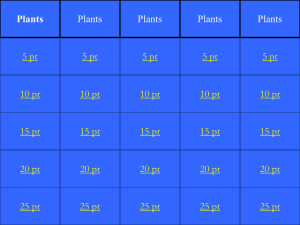Plant Physiology
advertisement
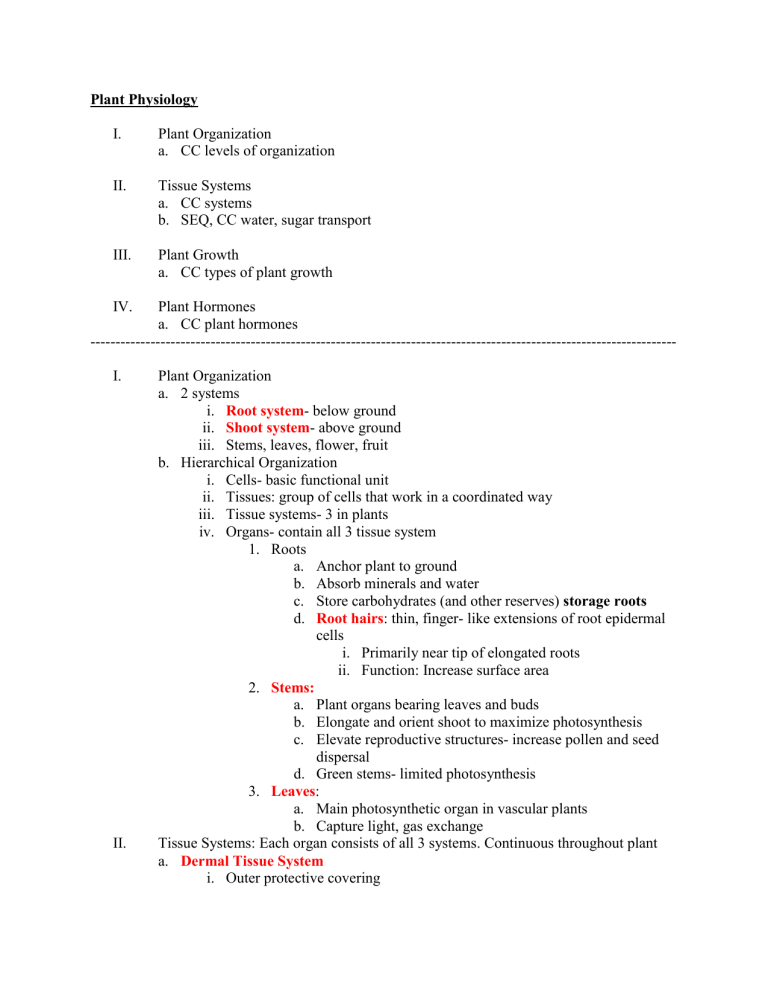
Plant Physiology I. Plant Organization a. CC levels of organization II. Tissue Systems a. CC systems b. SEQ, CC water, sugar transport III. Plant Growth a. CC types of plant growth IV. Plant Hormones a. CC plant hormones --------------------------------------------------------------------------------------------------------------------I. II. Plant Organization a. 2 systems i. Root system- below ground ii. Shoot system- above ground iii. Stems, leaves, flower, fruit b. Hierarchical Organization i. Cells- basic functional unit ii. Tissues: group of cells that work in a coordinated way iii. Tissue systems- 3 in plants iv. Organs- contain all 3 tissue system 1. Roots a. Anchor plant to ground b. Absorb minerals and water c. Store carbohydrates (and other reserves) storage roots d. Root hairs: thin, finger- like extensions of root epidermal cells i. Primarily near tip of elongated roots ii. Function: Increase surface area 2. Stems: a. Plant organs bearing leaves and buds b. Elongate and orient shoot to maximize photosynthesis c. Elevate reproductive structures- increase pollen and seed dispersal d. Green stems- limited photosynthesis 3. Leaves: a. Main photosynthetic organ in vascular plants b. Capture light, gas exchange Tissue Systems: Each organ consists of all 3 systems. Continuous throughout plant a. Dermal Tissue System i. Outer protective covering ii. 1st line of defense against physical damage, pathogens iii. Nonwoody plants 1. Epidermis: Single layer of tightly packed cells 2. Cuticle: waxy coating- helps prevent water loss iv. Wood plants- periderm (bark) replaces epidermis v. Dermal tissue functions: 1. Absorption of water, minerals at root hairs 2. Reduce water loss, reflect sunlight, defend against insects 3. Guard cells- specialized cells in shoots- gas exchange b. Ground tissue system i. Most of plant ii. Includes cells specialized for: 1. Storage 2. Photosynthesis 3. Support 4. Short distance transport c. Vascular Tissue System i. Transport materials throughout plant body ii. Mechanical support iii. 2 types of vascular systems 1. Xylem: conducts H2O dissolved minerals upward from roots a. 1.) soil b. 2.) root tissue c. 3.) root xylem d. 4.) stem xylem e. 5.) leaf xylem f. 6.) leaf mesophyll g. 7.) stomata h. 8.) atmosphere 2. Phloem: Transport sugars from where made (mostly leaves) to where needed (usually roots and sites of growth) 3. Cohesion- tension hypothesis (xylem) a. During photosynthesis, stomata open, H2O leaves leaves i. Transpiration b. Creates tension- like soda straw i. H2O in root xylem pulled into stem ii. H2O in root xylem pulled into stem 4. Phloem conducts dissolved sugar a. Bidirectional movement- translocation b. Source: area with excess sugar c. Sink: area of storage or metabolism d. Moves source sink e. Made in leaves stored in roots f. Stored in roots throughout plant for growth, maintenance 5. Pressure- Flow hypothesis (phloem) 6. III. IV. a. Explanation for movements of sugars in phloem b. Suggests translocation occurs via pressure gradient c. At source- high pressure- sugar loaded in phloem d. At sink- low pressure- sugar removed from phloem Plasmodesmata a. Cytoplasmis connections b. Allows molecules, ions to pass between cells c. Important in plants, we’ll see similar connections in animals Plant Growth a. Indeterminate growth i. Occurs throughout life of plant ii. Continuous except for dormant periods iii. Keep growing due to perpetually dividing, unspecialized tissue iv. Growth at meristems b. 1ogrowth: increase length by adding more cells i. All plants have 1o growth c. 2o growth: increase girth (circumference) of plant i. Only woody plants have secondary growth Plant Hormones a. Introduction to plant hormones i. Organic compounds- chemical messengers ii. Control specific physiological responses in plants iii. Also known as plant growth regulators iv. General characteristics 1. Active at very low concentrations 2. Can have multiple effects 3. Interact- hard to tell cause of a specific effect 4. Natural or synthetic v. Tropisms: 1. Directional growth response to environmental stimulus often due to hormones vi. Directional 1. Positive- grows towards stimulus 2. Negative- grows away from stimulus 3. Ex: phototropism – in response to light b. Auxins i. 1st plant hormone discovered- directional growth towards light ii. Darwin’s experiments 1. Involved phototropism: 2. Coloeoptile: 1st part of grass seeding to emerge from soil 3. When exposed to light from one direction a. Bends towards light 4. Phototropism experiments a. Shielded or removed tip no bending b. Shield with transparent cap bending c. Shield below tip bending d. Conclusion: Coleoptile tip responsible for light sensing e. Postulated: signal transmitted from tip to elongating region iii. Boysen- Jensen experiment 1. Dutch botanist, 1913 2. Separated tip from rest of coleoptile with gelatin cube- bending 3. Separated with mica (impermeable) no bending iv. Auxins 1. Group of natural artificial hormones (many synthetic) 2. Main site of production- shoot apical meristem 3. Transport is polar- unidirectional, shoot root 4. Triggers cell elongation 5. Acid growth hypothesis v. Phototropism explained 1. Light exposure auxin produced moves laterally to shaded side, down stem a. Shade side elongates 2. plant bends towards light vi. Practical applications 1. Herbicides a. Synethic auxins- 2,4 D, 2,4,5-T b. Agent Orange- 50/50 mix 2. Fruit development a. Can be sprayed to induce fruit development b. Used in green houses c. Cytokinins i. Control of cell division and differentiation ii. Produced in actively growing tissue 1. Roots, embryos, fruit iii. Stimulate cytokinesis (where they got their name) iv. Act with Auxin 1. Experiment- cultured ground tissue 2. Cytokinin does not produce cytokinin on its own 3. Cytokinin + auxin cytokinin d. Abscisic Acid (ABA) i. Name is misnomer- not related to abscission (falling of leaves) ii. Seed dormancy- cannot germinate until washed out iii. Increases likelihood that seed only germinates under suitable conditionslots of water in spring- adaptation e. Ethylene (C2H4) i. Unique among plant hormones ii. Triple response to mechanical stress 1. Behavior to avoid obstacles 2. Produced when growing shoot encounters obstacle iii. 3 components of triple response 1. Slow elongation 2. thicken stem 3. Curve, grow horizontally

